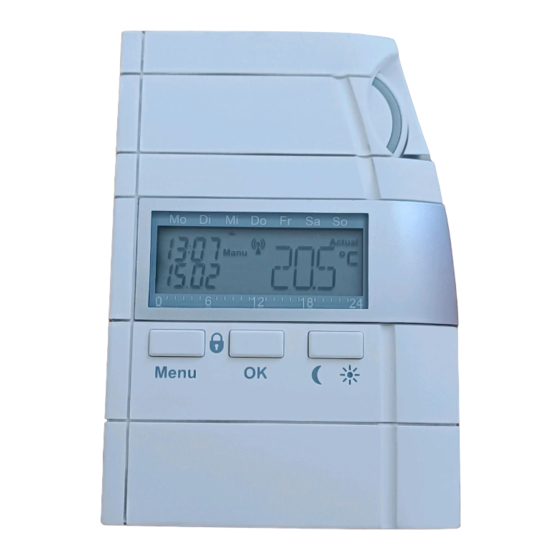
HomeMatic HM-CC-TC Montageanleitung Und Bedienungsanleitung
Vorschau ausblenden
Andere Handbücher für HM-CC-TC:
- Montageanleitung und bedienungsanleitung (60 Seiten) ,
- Montageanleitung und bedienungsanleitung (60 Seiten)
Inhaltszusammenfassung für HomeMatic HM-CC-TC
- Seite 30 eQ-3 AG Maiburger Straße 29 D-26789 Leer www.eQ-3.com...
-
Seite 31: Adapter Für Danfoss Heizkörperventile
Montageanleitung Adapter für Danfoss Heizkörperventile _______________________________________ 1. Ausgabe Deutsch 03/2008 Dokumentation © 2008 eQ-3 Ltd., Hong Kong Alle Rechte vorbehalten. Ohne schriftliche Zustimmung des Herausgebers darf diese Anleitung auch nicht auszugsweise in irgendeiner Form reproduziert werden oder un- ter Verwendung elektronischer, mechanischer oder chemischer Verfahren vervielfältigt oder verarbeitet werden. - Seite 32 Gefahrenhinweis Achtung: Wenn der Thermostatkopf demontiert wird, öffnet sich das Ventil am Heizkörper. Unter Umständen können sich der Heizkörper und dessen Anschlüsse dann stark erwärmen. Ggf. sollte die Heizungsanlage während der Montage des Adapters außer Betrieb genommen, oder der Heizkörper an der Rücklaufverschraubung abgesperrt werden.
- Seite 33 Welcher Adapterring zu welchem Ventil gehört, ist aus den nebenstehenden Bildern ersichtlich. Die Adapterringe RA und RAV sind nach dem Aufrasten mit der beiliegenden Mutter und Schraube zu befestigen. Bei Ventilen vom Typ RAV ist außerdem die Stößelverlängerung auf den Ventil- stößel zu stecken.
- Seite 34 eQ-3 AG Maiburger Str. 29 D-26789 Leer www.eQ-3.com...
-
Seite 35: Adapter Für Heizkörperventile Mit M28 X 1,5 Mm Anschlussgewinde
Montageanleitung Adapter für Heizkörperventile mit M28 x 1,5 mm Anschlussgewinde _______________________________________ 2. Ausgabe Deutsch 01/2008 Dokumentation © 2007 eQ-3 Ltd., Hong Kong Alle Rechte vorbehalten. Ohne schriftliche Zustimmung des Herausgebers darf diese Anleitung auch nicht auszugsweise in irgendeiner Form reproduziert werden oder un- ter Verwendung elektronischer, mechanischer oder chemischer Verfahren vervielfältigt oder verarbeitet werden. - Seite 36 Gefahrenhinweis Achtung: Wenn der Thermostatkopf demontiert wird, öffnet sich das Ventil am Heizkörper. Unter Umständen können sich der Heizkörper und dessen Anschlüsse dann stark erwärmen. Ggf. sollte die Heizungsanlage während der Montage des Adapters außer Betrieb genommen, oder der Heizkörper an der Rücklaufverschraubung abgesperrt werden.
- Seite 37 Montage des Adapters Stecken Sie den Verlängerungsstift von der Innenseite in den Adapteraufsatz (B). Dies ist nur in einer Position möglich, da eine Seite des Verlängerungsstiftes als Verdrehschutz abgeflacht ist. Drehen Sie den Thermostatkopf auf den Maximalwert (C) (links herum / gegen den Uhrzeigersinn).
- Seite 38 eQ-3 AG Maiburger Str. 29 D-26789 Leer www.eQ-3.com...
- Seite 39 Montageanleitung Adapter für Heizkörperventile mit M28 x 1,5 mm Anschlussgewinde _______________________________________ 2. Ausgabe Deutsch 01/2008 Dokumentation © 2007 eQ-3 Ltd., Hong Kong Alle Rechte vorbehalten. Ohne schriftliche Zustimmung des Herausgebers darf diese Anleitung auch nicht auszugsweise in irgendeiner Form reproduziert werden oder un- ter Verwendung elektronischer, mechanischer oder chemischer Verfahren vervielfältigt oder verarbeitet werden.
- Seite 40 Gefahrenhinweis Achtung: Wenn der Thermostatkopf demontiert wird, öffnet sich das Ventil am Heizkörper. Unter Umständen können sich der Heizkörper und dessen Anschlüsse dann stark erwärmen. Ggf. sollte die Heizungsanlage während der Montage des Adapters außer Betrieb genommen, oder der Heizkörper an der Rücklaufverschraubung abgesperrt werden.
- Seite 41 Montage des Adapters Stecken Sie den Verlängerungsstift von der Innenseite in den Adapteraufsatz (B). Dies ist nur in einer Position möglich, da eine Seite des Verlängerungsstiftes als Verdrehschutz abgeflacht ist. Drehen Sie den Thermostatkopf auf den Maximalwert (C) (links herum / gegen den Uhrzeigersinn).
- Seite 42 eQ-3 AG Maiburger Str. 29 D-26789 Leer www.eQ-3.com...
-
Seite 43: Adapter Für Oventrop Heizkörperventile Mit M30 X 1,0 Mm Gewinde
Montageanleitung Adapter für Oventrop Heizkörper- ventile mit M30 x 1,0 mm Gewinde _______________________________________ 2. Ausgabe Deutsch 01/2008 Dokumentation © 2007 eQ-3 Ltd., Hong Kong Alle Rechte vorbehalten. Ohne schriftliche Zustimmung des Herausgebers darf diese Anleitung auch nicht auszugsweise in irgendeiner Form reproduziert werden oder un- ter Verwendung elektronischer, mechanischer oder chemischer Verfahren vervielfältigt oder verarbeitet werden. - Seite 44 Gefahrenhinweis Achtung: Wenn der Thermostatkopf demontiert wird, öffnet sich das Ventil am Heizkörper. Un- ter Umständen können sich der Heizkörper und dessen Anschlüsse dann stark erwärmen. Ggf. sollte die Heizungsanlage während der Montage des Adapters außer Betrieb genommen, oder der Heizkörper an der Rücklaufverschraubung abge- sperrt werden.
- Seite 46 eQ-3 AG Maiburger Str. 29 D-26789 Leer www.eQ-3.com...
- Seite 47 Montageanleitung Adapter für Oventrop Heizkörper- ventile mit M30 x 1,0 mm Gewinde _______________________________________ 2. Ausgabe Deutsch 01/2008 Dokumentation © 2007 eQ-3 Ltd., Hong Kong Alle Rechte vorbehalten. Ohne schriftliche Zustimmung des Herausgebers darf diese Anleitung auch nicht auszugsweise in irgendeiner Form reproduziert werden oder un- ter Verwendung elektronischer, mechanischer oder chemischer Verfahren vervielfältigt oder verarbeitet werden.
- Seite 48 Gefahrenhinweis Achtung: Wenn der Thermostatkopf demontiert wird, öffnet sich das Ventil am Heizkörper. Un- ter Umständen können sich der Heizkörper und dessen Anschlüsse dann stark erwärmen. Ggf. sollte die Heizungsanlage während der Montage des Adapters außer Betrieb genommen, oder der Heizkörper an der Rücklaufverschraubung abge- sperrt werden.
- Seite 50 eQ-3 AG Maiburger Str. 29 D-26789 Leer www.eQ-3.com...
-
Seite 51: Adapter Für Vaillant Heizkörperventile
Montageanleitung Adapter für Vaillant Heizkörperventile _______________________________________ 2. Ausgabe Deutsch 01/2008 Dokumentation © 2007 eQ-3 Ltd., Hong Kong Alle Rechte vorbehalten. Ohne schriftliche Zustimmung des Herausgebers darf diese Anleitung auch nicht auszugsweise in irgendeiner Form reproduziert werden oder un- ter Verwendung elektronischer, mechanischer oder chemischer Verfahren vervielfältigt oder verarbeitet werden. - Seite 52 Gefahrenhinweis Achtung: Wenn der Thermostatkopf demontiert wird, öffnet sich das Ventil am Heizkörper. Unter Umständen können sich der Heizkörper und dessen Anschlüsse dann stark erwärmen. Ggf. sollte die Heizungsanlage während der Montage des Adapters außer Betrieb genommen, oder der Heizkörper an der Rücklaufverschraubung abgesperrt werden.
- Seite 53 Setzen Sie jetzt eine der Hälften der Schelle um Adapteraufsatz und Ventil. Hierbei fasst die obere Kante (I) in die Nut am Adapteraufsatz (G) und die untere Kante (J) in die Nut am Ventil (H). Die beiden Rippen (K) sind so auszurichten, dass sie sich an der abgeflachten Kante und am Sechskant anlegen (E und F).
















